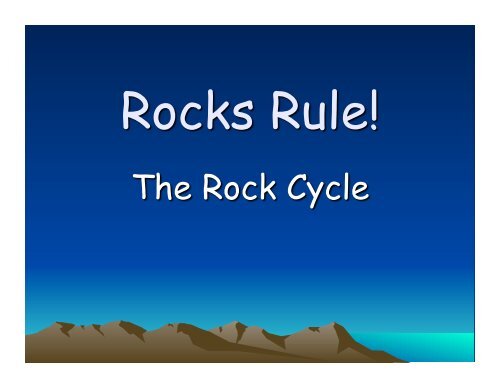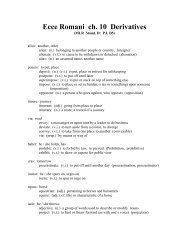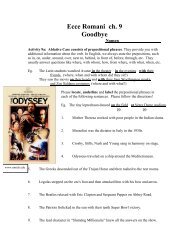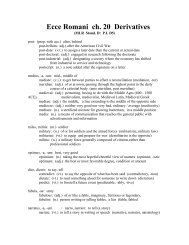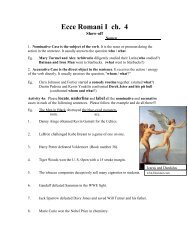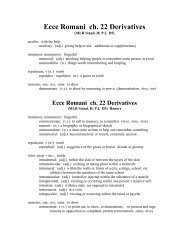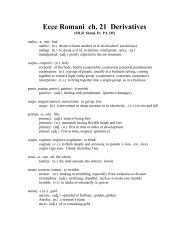Rocks Rule! The Rock Cycle.pdf
Rocks Rule! The Rock Cycle.pdf
Rocks Rule! The Rock Cycle.pdf
Create successful ePaper yourself
Turn your PDF publications into a flip-book with our unique Google optimized e-Paper software.
<strong>The</strong> <strong>Rock</strong> <strong>Cycle</strong> <br />
http://ags.ou.edu/~msoreg/G1104/rock_cycle/rock_cycle.html
• While the rock cycle<br />
has no beginning and<br />
no end, it does contain<br />
three main types of<br />
rocks: Igneous,<br />
Sedimentary, and<br />
Metamorphic. <strong>The</strong>se<br />
rock types can turn<br />
into each other by<br />
several natural<br />
processes on Earth.<br />
http://www.teachnet-lab.org/ps101/bglasgold/rocks/<br />
EF<strong>Cycle</strong>P2.gif
• Magma is molten<br />
rock found deep in<br />
the Earth. It rises<br />
to Earth’s surface<br />
through openings like<br />
those at the top of a<br />
volcano. It gives rise<br />
to IGNEOUS ROCK.<br />
• http://www.volcanogallery.com/<br />
volcano_videoclips.htm<br />
Click<br />
on the<br />
picture<br />
to see<br />
the<br />
lava<br />
flow.
• Magma is molten rock that flows under Earth’s surface. It<br />
can cool slowly in pockets deep underground (granite). Lava is<br />
molten rock that flows out of the Earth. Lava cools and<br />
crystallizes quickly (pumice). Either way, IGNEOUS ROCK is<br />
formed.<br />
CLICK LINK<br />
http://www.fi.edu/fellows/fellow1/<br />
rocks/create/igneous.htm<br />
Pegmatite<br />
http://facstaff.gpc.edu/~pgore/gore.htm<br />
Click on this link:<br />
http://geology.com/rocks/<br />
igneous-rocks.shtml
• Basalt (igneous rock) is<br />
the most common type of<br />
rock on Earth. It forms<br />
most of the ocean floor.<br />
It is igneous rock that<br />
forms from quickly<br />
cooling lava. It can be<br />
broken into smaller pieces<br />
by the pounding of ocean<br />
waves. This process is<br />
called weathering.<br />
This picture shows A'a' flowing over<br />
pahoehoe on Kilauea Volcano, Hawaii<br />
http://martianchronicles.wordpress.com/2008/08/25/hot-lava-typesof-lava/<br />
http://www.cerritos.edu/esci/images/<br />
ESCI_110_Lecture_notes_images/basalt.jpg
• Igneous <strong>Rock</strong> also undergoes<br />
erosion (gradual wearing away<br />
of rock by wind and water) and<br />
turns into fine particles called<br />
sediment. Sand is a type of<br />
sediment.<br />
• Click on this web site for more<br />
information on sand collecting:<br />
• http://www.paccd.cc.ca.us/<br />
instadmn/physcidv/geol_dp/<br />
dndougla/SAND/SANDHP.htm
For thousands, even millions of<br />
years, little pieces of our earth have<br />
been eroded--broken down and worn<br />
away by wind and water. <strong>The</strong>se little<br />
bits of our earth are washed<br />
downstream where they settle to the<br />
bottom of the rivers, lakes, and<br />
oceans. Layer after layer of eroded<br />
earth is deposited on top of each.<br />
<strong>The</strong>se layers are pressed down<br />
more and more through time, until<br />
the bottom layers slowly turn into<br />
SEDIMENTARY ROCK. One example<br />
is sandstone.<br />
References:<br />
http://www.fi.edu/fellows/fellow1/oct98/create/sediment.htm<br />
http://movingtoward.com/images/sed%20rock.jpg
• As sediments fall to the<br />
bottom of a lake, they<br />
may cover a dead fish.<br />
Over time this fish<br />
becomes a fossil<br />
trapped in time while<br />
the sediments compact<br />
and cement together to<br />
form Sedimentary <strong>Rock</strong>.<br />
http://lovingthebigisland.files.wordpress.com/2009/06/fossil-fish-1.jpg
• METAMORPHIC ROCKS are<br />
rocks that have "morphed" into<br />
another kind of rock. <strong>The</strong>se<br />
rocks were once igneous or<br />
sedimentary rocks. How do<br />
sedimentary and igneous rocks<br />
change <strong>The</strong> rocks are under<br />
tons and tons of pressure,<br />
which fosters heat build up, and<br />
this causes them to change. If<br />
you exam metamorphic rock<br />
samples closely, you'll discover<br />
how flattened some of the<br />
grains in the rock are. One<br />
example is Gneiss.<br />
• Reference:<br />
• http://www.fi.edu/fellows/fellow1/oct98/<br />
expert/gneiss.htm
http://mitchell.needham.k12.ma.us/technology/lessons/rocks/image/rock_cycle.jpg
This is a great example of weathering.<br />
Click on the link below:<br />
http://www.franconianotchstatepark.com/oldman.html
• http://www.classzone.com/books/<br />
earth_science/terc/content/investigations/<br />
es0602/es0602page02.cfm<br />
• Answer the questions from part 3 of the<br />
animation in your notebook.
• How can Metamorphic <strong>Rock</strong><br />
change into Igneous <strong>Rock</strong>
• How can Sedimentary <strong>Rock</strong><br />
change into Igneous <strong>Rock</strong>
• How can Igneous <strong>Rock</strong> turn<br />
into Metamorphic <strong>Rock</strong>
• Why do we use the term <strong>Rock</strong><br />
<strong>Cycle</strong> when describing how one<br />
rock type changes into another


